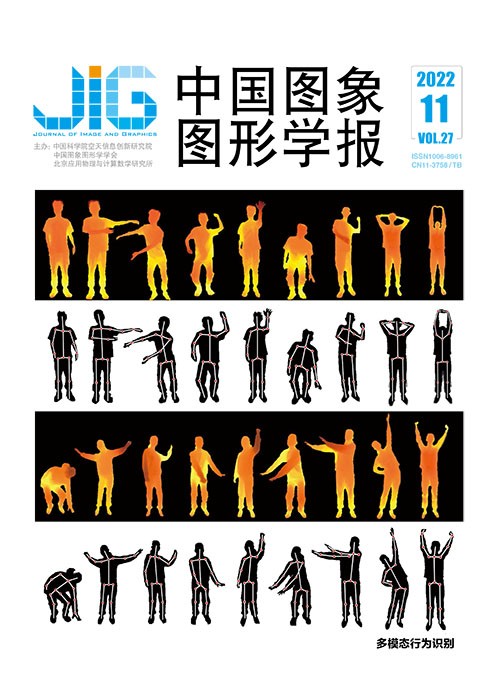
集成相异性准则与熵率超像素的图像分割模型
摘 要
目的 高精度图像分割是生物医学图像处理中的一个重要问题。在磁共振成像过程中,噪声和强度不均匀很大程度影响图像分割的精度。因此,提出了一种基于相异性准则熵率超像素的多模态高精度图像分割网络。方法 采用熵率超像素分割算法对多模态图像进行预分割得到超像素块,提出新的融合算法对其重新编号,建立超像素图,该图中的每一个超像素块构成无向图的一个结点;利用每个结点的灰度值提取特征向量,通过相异性权重判断结点间的相关性,构建相邻结点的特征序列;将特征序列作为双向长短期记忆模型(bi-directional long short-term memory,BiLSTM)的输入,经过训练和测试,得到最终的分割结果。结果 本文方法在BrainWeb、MRBrainS和BraTS2017数据集上与主流算法进行了对比。在BrainWeb数据集上,本文方法的像素精度(pixel accuracy,PA)和骰子相似系数(Dice similarity coefficient,DSC)分别为98.93%、97.71%,比LSTM-MA (LSTM method with multi-modality and adjacency constraint)提升了1.28%、2.8%。在MRBrainS数据集上,本文方法的PA为92.46%,DSC为84.74%,比LSTM-MA提升了0.63%、1.44%。在BraTS2017数据集上,本文方法的PA和DSC上分别为98.80%,99.47%,也取得了满意的分割结果。结论 提出的分割网络在多模态图像分割应用中,获得了较好的分割结果,对图像强度不均匀和噪声有较好的鲁棒性。
关键词
An image segmentation model in combination with dissimilarity criterion and entropy rate super-pixel
Gu Anqi1, Shan Xinxin2, Wen Ying2(1.School of Comupter Science and Technology, East China Normal University, Shanghai 200062, China;2.School of Communication and Electronic Engineering, East China Normal University, Shanghai 200241, China) Abstract
Objective High-precision image segmentation is a key issue for biomedical image processing. It can aid to understand the anatomical information of biological tissues better. But, the segmentation precision is restricted by the non-uniformity of image intensity and noise-related issues in the process of magnetic resonance imaging (MRI). In addition, more image segmentation effects are constrained by information loss due to multi-modality and spatial neighborhood relations of medical images. Our research is focused on an image segmentation model in combination with dissimilarity criterion and entropy rate super-pixel. Method Our method is based on a segmentation model in the context of multi-modality feature fusion. This model is composed of three parts as mentioned below:1) thanks to the entropy rate super-pixel segmentation algorithm (entropy rate super-pixel, ERS), the multi-modality image is pre-segmented to obtain super-pixel blocks, and a new fusion algorithm is illustrated to renumber them, the super-pixel image is then established. The accurate segmentation of common areas in the tissue area is guaranteed in terms of multi-modality fusion-added, and the boundaries of the tissue area can be divided more accurately, and the overall segmentation accuracy is improved. 2) Each super-pixel block is illustrated by a node of the undirected image, and the feature vector is extracted by the gray value of each node. The correlation between nodes is judged by dissimilarity weight, and the feature sequence of adjacent nodes is constructed. The multi-modality and spatial neighborhood information develop the fineness of the boundary, the robustness of local area noise and intensity non-uniformity. Finally, the feature sequence is used as the input of bi-directional long/short-term memory model. To improve the segmentation accuracy, the cross entropy loss is used for training. Result Our method is compared to some popular algorithms in the context of BrainWeb, MRbrains and BraTS2017 datasets. The BrainWeb dataset is regarded as a simulation dataset based on brain anatomical structure, which contains MR images of T1, T2 and PD. Compared to LSTM-MA(LSTM method with multi-modality and adjacency constraint), our pixel accuracy (PA) is 98.93% (1.28% higher) and the Dice similarity coefficient (DSC) is 97.71% (2.8 higher). The MRbrains dataset contains the ground truth of brain-relevant MR images, which consists of MR image of T1, T1IR and FLAIR modalities. Our demonstration achieves 92.46% in relation to PA metric and 84.74% in terms of DSC metric, which are 0.63% and 1.44% higher than LSTM-MA. The dataset of BraTS2017 is related to the four modalities of MR image like T1, T1CE, T2 and FLAIR. We choose three modalities of them (T1CE, T2 and FLAIR). Final PA and DSC metrics are reached to 98.80% and 99.47%. Furthermore, our convergence speed is in comparison with some popular deep learning techniques like convolutional recurrent decoding network(CRDN), semantic flow network(SFNet) and UNet++. Our competitive convergence results can be obtained when the number of iterations is 40. Conclusion Our analysis can optimize current multi-modality features further. Multi-modality super-pixel blocks are fused by a new fusion algorithm, and a better feature sequence is constructed via the dissimilarity criterion. The final segmentation result is obtained through training and testing of the bidirectional long/short-term memory network. The experimental results show that our method can optimize the applications of image segmentation, and enhance the robustness of image intensity-oriented non-uniformity and noise-related.
Keywords
image segmentation multi-modality super-pixel bi-directional long short term memory model(BiLSTM) noise robustness
|



 中国图象图形学报 │ 京ICP备05080539号-4 │ 本系统由
中国图象图形学报 │ 京ICP备05080539号-4 │ 本系统由